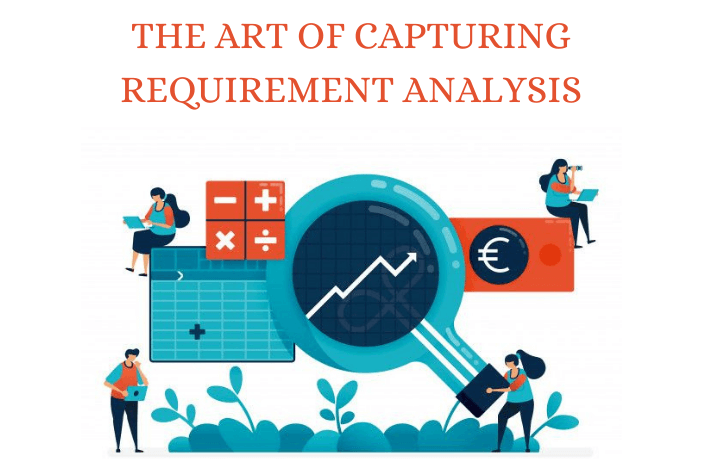The Art Of Capturing Requirement Analysis

At first glance, the most important thing in developing a new product is gathering requirements. Though spending tremendous time and resources on development, there can be a mismatch between the required product and the final product. Many times requirements gathering is underestimated on multiple levels. When budgets are thin, timelines are tight, and scope is creeping, requirements documentation tends to be the first deliverable to go and the last deliverable to be considered.
There’s a common refrain that gets uttered at the end of unsuccessful projects: “The requirements weren’t clear.” Fingers start pointing, blame gets thrown around, and no one ends up happy. Thankfully, there’s a simple way to alleviate that problem, and it’s as obvious as it is challenging: requirements gathering.
What is Requirements Analysis?
Requirement analysis is significant and essential activity after elicitation. We analyze, refine, and scrutinize the gathered requirements from the stakeholders to make consistent and unambiguous requirements. After the completion of the analysis, it is expected that the understandability of the project may improve significantly. This is always done in the early phase of any project to ensure that the final product conforms to all the requirements.
This process often involves a set of activities including:
- Requirements elicitation: communicating with customers and users to determine what their requirements to understand user needs
- Requirements modeling: codifying that information in the form of user stories, such as natural-language documents, use cases, user stories, or process specifications.
- Analyzing requirements: determining whether the stated requirements are unclear, incomplete, ambiguous, or contradictory, and then resolving these issues.
- Review and retrospective: Team members reflect on what happened in the iteration and identifies actions for improvement going forward.
Requirements Analysis Techniques:
There are different techniques used for business Requirements Analysis. Below is a list of different business Requirements Analysis Techniques:
1. Business process modeling notation (BPMN)
2. UML (Unified Modeling Language)
3. Flowchart technique
4. Data flow diagram
5. Role Activity Diagrams (RAD)
6. Gantt Charts
7. IDEF (Integrated Definition for Function Modeling)
8. Gap Analysis
Let go into detail
1. Business Process Modeling and Notation (BPMN)
Business Process Model and Notation is used to create process flowcharts, although BPMN has its symbols and elements. These graphs simplify understanding the business process. BPMN is widely popular by business analysts as a process improvement methodology. The biggest profit of using BPMN is that it is easier to share, and most modeling tools support BPMN.
2. UML (Unified Modeling Language)
UML consists of an integrated set of diagrams that are created to specify, visualize, construct and document the artifacts of a software system. It is a useful technique while creating object-oriented software and working with the software development process. In UML, graphical notations are used to represent the design of a software project. UML also helps in validating the architectural design of the software.
3. Flowchart technique
A flowchart depicts the sequential flow and control logic of a related set of activities. They are in different forms such as linear, cross-functional, and top-down. The flowchart can represent system interactions, data flows, etc. Flow charts are easy to understand and can be used by both the technical and non-technical team members. The flowchart technique helps in showcasing the critical attributes of a process.
4. Data flow diagram
This technique is used to visually represent systems and processes that are complex and difficult to describe in text. Data flow diagrams represent the flow of information through a process or a system. It also includes the data inputs and outputs, data stores, and the various sub-processes through which the data moves. DFD describes various entities and their relationships with the help of standardized notations and symbols. By visualizing all the elements of the system it is easier to identify any shortcomings. These shortcomings are then eliminated in a bid to create a robust solution.
5. Role Activity Diagrams (RAD)
A Role-activity diagram (RAD) is a rule-oriented process model that represents role-activity diagrams. Role activity diagrams are a high-level view that captures the dynamics and role structure of an organization. Roles are used to grouping together activities into units of responsibilities. Activities are the basic parts of a role. An activity may be either carried out in isolation or it may require coordination with other activities within the role.
6. Gantt Charts
Gantt charts are used in project planning as they provide a visual representation of tasks that are scheduled along with the timelines. The Gantt charts help to know what is scheduled to be completed by which date. The start and end dates of all the tasks in the project can be seen in a single view.
7. IDEF (Integrated Definition for Function Modeling)
The integrated definition for function modeling (IDEFM) technique represents the functions of a process and their relationships to child and parent systems with the help of a box. It provides a blueprint to gain an understanding of an organization’s system
8. Gap Analysis
Gap analysis is a technique that helps to analyze the gaps in the performance of a software application to determine whether the business requirements are met or not. It also involves the steps that are to be taken to ensure that all the business requirements are met successfully. Gap denotes the difference between the present state and the target state. Gap analysis is also known as need analysis, need assessment, or need-gap analysis.
Summary
For the success of a project, it is of utmost importance to analyze project requirements at the time gathering as well as throughout the lifecycle of the project. It helps to keep the requirements in line with the needs of the business. A good project requirements analysis process will render a software application that caters to the objectives of the business set forth. Hope this blog was useful and are you looking for such kind of analysts for your next project just drop a line and we will be back within 24hrs.

















